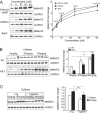Screening with an NMNAT2-MSD platform identifies small molecules that modulate NMNAT2 levels in cortical neurons
- PMID: 28266613
- PMCID: PMC5358788
- DOI: 10.1038/srep43846
Screening with an NMNAT2-MSD platform identifies small molecules that modulate NMNAT2 levels in cortical neurons
Erratum in
-
Corrigendum: Screening with an NMNAT2-MSD platform identifies small molecules that modulate NMNAT2 levels in cortical neurons.Sci Rep. 2017 Apr 27;7:46780. doi: 10.1038/srep46780. Sci Rep. 2017. PMID: 28447617 Free PMC article. No abstract available.
Abstract
Nicotinamide mononucleotide adenylyl transferase 2 (NMNAT2) is a key neuronal maintenance factor and provides potent neuroprotection in numerous preclinical models of neurological disorders. NMNAT2 is significantly reduced in Alzheimer's, Huntington's, Parkinson's diseases. Here we developed a Meso Scale Discovery (MSD)-based screening platform to quantify endogenous NMNAT2 in cortical neurons. The high sensitivity and large dynamic range of this NMNAT2-MSD platform allowed us to screen the Sigma LOPAC library consisting of 1280 compounds. This library had a 2.89% hit rate, with 24 NMNAT2 positive and 13 negative modulators identified. Western analysis was conducted to validate and determine the dose-dependency of identified modulators. Caffeine, one identified NMNAT2 positive-modulator, when systemically administered restored NMNAT2 expression in rTg4510 tauopathy mice to normal levels. We confirmed in a cell culture model that four selected positive-modulators exerted NMNAT2-specific neuroprotection against vincristine-induced cell death while four selected NMNAT2 negative modulators reduced neuronal viability in an NMNAT2-dependent manner. Many of the identified NMNAT2 positive modulators are predicted to increase cAMP concentration, suggesting that neuronal NMNAT2 levels are tightly regulated by cAMP signaling. Taken together, our findings indicate that the NMNAT2-MSD platform provides a sensitive phenotypic screen to detect NMNAT2 in neurons.
Conflict of interest statement
The authors declare no competing financial interests.
Figures






Similar articles
-
CREB-activity and nmnat2 transcription are down-regulated prior to neurodegeneration, while NMNAT2 over-expression is neuroprotective, in a mouse model of human tauopathy.Hum Mol Genet. 2012 Jan 15;21(2):251-67. doi: 10.1093/hmg/ddr492. Epub 2011 Oct 25. Hum Mol Genet. 2012. PMID: 22027994 Free PMC article.
-
Impact of Genetic Reduction of NMNAT2 on Chemotherapy-Induced Losses in Cell Viability In Vitro and Peripheral Neuropathy In Vivo.PLoS One. 2016 Jan 25;11(1):e0147620. doi: 10.1371/journal.pone.0147620. eCollection 2016. PLoS One. 2016. PMID: 26808812 Free PMC article.
-
NMNAT2:HSP90 Complex Mediates Proteostasis in Proteinopathies.PLoS Biol. 2016 Jun 2;14(6):e1002472. doi: 10.1371/journal.pbio.1002472. eCollection 2016 Jun. PLoS Biol. 2016. PMID: 27254664 Free PMC article.
-
Expression, localization, and biochemical characterization of nicotinamide mononucleotide adenylyltransferase 2.J Biol Chem. 2010 Dec 17;285(51):40387-96. doi: 10.1074/jbc.M110.178913. Epub 2010 Oct 13. J Biol Chem. 2010. PMID: 20943658 Free PMC article.
-
NMNAT2: An important metabolic enzyme affecting the disease progression.Biomed Pharmacother. 2023 Feb;158:114143. doi: 10.1016/j.biopha.2022.114143. Epub 2022 Dec 16. Biomed Pharmacother. 2023. PMID: 36528916 Review.
Cited by
-
Glucagon-like peptide 1 (GLP-1) receptor agonists in experimental Alzheimer's disease models: a systematic review and meta-analysis of preclinical studies.Front Pharmacol. 2023 Sep 13;14:1205207. doi: 10.3389/fphar.2023.1205207. eCollection 2023. Front Pharmacol. 2023. PMID: 37771725 Free PMC article.
-
The key role of the NAD biosynthetic enzyme nicotinamide mononucleotide adenylyltransferase in regulating cell functions.IUBMB Life. 2022 Jul;74(7):562-572. doi: 10.1002/iub.2584. Epub 2021 Dec 5. IUBMB Life. 2022. PMID: 34866305 Free PMC article. Review.
-
Inhibitors of NAD+ Production in Cancer Treatment: State of the Art and Perspectives.Int J Mol Sci. 2024 Feb 8;25(4):2092. doi: 10.3390/ijms25042092. Int J Mol Sci. 2024. PMID: 38396769 Free PMC article. Review.
-
Vincristine- and bortezomib-induced neuropathies - from bedside to bench and back.Exp Neurol. 2021 Feb;336:113519. doi: 10.1016/j.expneurol.2020.113519. Epub 2020 Oct 29. Exp Neurol. 2021. PMID: 33129841 Free PMC article. Review.
-
Applying hiPSCs and Biomaterials Towards an Understanding and Treatment of Traumatic Brain Injury.Front Cell Neurosci. 2020 Nov 12;14:594304. doi: 10.3389/fncel.2020.594304. eCollection 2020. Front Cell Neurosci. 2020. PMID: 33281561 Free PMC article. Review.
References
Publication types
MeSH terms
Substances
Grants and funding
LinkOut - more resources
Full Text Sources
Other Literature Sources

